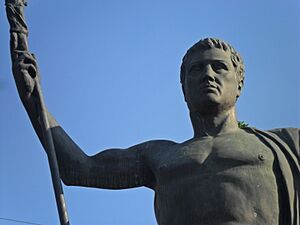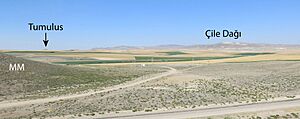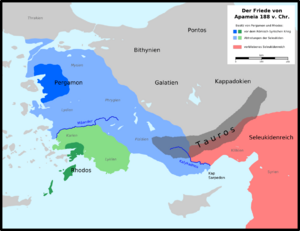Galatian War facts for kids
Quick facts for kids Galatian War |
|||||||
|---|---|---|---|---|---|---|---|
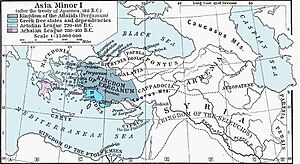 A map showing the location of Galatia. |
|||||||
|
|||||||
| Belligerents | |||||||
|
Roman Republic Pergamum |
||||||
| Commanders and leaders | |||||||
| Eposognatus Orgiagon Chiomara Komboiomaros Gaulotos |
Gnaeus Manlius Vulso Attalus II |
||||||
| Strength | |||||||
| Over 50,000 men (overstated) | 30 - 35,000 Roman and allied forces 2,800 Pergamese troops |
||||||
| Casualties and losses | |||||||
| 40,000 dead or captured at Mount Olympus (overstated) 8000 dead at Ancyra Tolistobogii and Tectosagi massacred |
Unknown | ||||||
The Galatian War was a war fought in 189 BC between the Galatian Gauls and the Roman Republic, supported by their ally Pergamum. The war was fought in Galatia in central Asia Minor, in present-day Turkey.
The Romans had just defeated the Seleucids in the Roman–Seleucid War and were in the midst of concluding a treaty with the latter. The Romans had then turned their attention towards the Gallic tribes of Galatia who had migrated to Asia Minor almost 100 years prior to this military engagement. Ancient historians noted that Gnaeus Manlius Vulso, the consul, had justified the invasion by saying that it was in retaliation for the Galatians supplying troops to the Seleucids during the war; and that Vulso had embarked on this campaign without the permission of the Roman Senate. However, modern historians argue that the war had either the covert or tacit approval of the Senate.
Joined by troops from Pergamum, the Romans marched inland, avoiding cities held by the Seleucids and attacking those which had not formally allied with the latter. Modern historians argue that this measure was taken to preserve the Roman–Seleucid truce while also weakening potential Seleucid allies. The Roman army then marched south, possibly to receive supplies from Roman ships at the port of Attalia (modern day Antalya). They then marched northward and unsuccessfully attempted to negotiate with the Galatians. The Romans defeated the Galatians in a battle on Mount Olympus, thought to be either Çile Dağı, a hill located between Gordion and Ancyra; or Alis Daği in northern Galatia, on the border with Bithynia. The Romans then defeated a larger Galatian contingent on a hill near Ancyra (modern day Ankara in Turkey).
These defeats forced the Galatians to sue for peace and the Romans returned to the coast of Asia Minor, where Vulso concluded the Treaty of Apamea with the Seleucids. The territories which the Roman army had marched through during this campaign were transferred from the Seleucids to either Rome or its allies, which modern historians argue was one of the purposes of the campaign. When Vulso returned to Rome, he was charged with threatening the peace between the Seleucids and Rome. He was cleared and was granted a triumph by the Senate. As a result of the campaign, Greco-Asian religious rituals and luxury began to be introduced to Rome, which ancient historians blamed for the moral decline of the Roman Republic. The loot brought by Vulso was used to repay Roman taxpayers and also for increased expenditure on infrastructure.
Background
In 191 BC, Antiochus the Great, the Emperor of the Seleucid Empire had invaded Greece. The Romans decided to intervene and they defeated the Seleucids at the Battle of Thermopylae. The defeat by Rome forced the Seleucids to retreat back to Asia Minor. The Romans followed them across the Aegean Sea and together with their allies, Pergamum, decisively defeated the Seleucids at the Battle of Magnesia. The Seleucids sued for peace and began settling it with Scipio Asiaticus.
Gnaeus Manlius Vulso, elected as the new consul and deployed to Asia, arrived at Ephesus in 189 BC, probably during the month of March or April. Vulso assumed command of Scipio's army, who were now idle since the Seleucids had been defeated. He was sent to conclude the treaty Scipio was arranging. However, he was not content with the task given to him and he started to plan a new war. He addressed the soldiers, congratulated them on their victory and then proposed a new war against the Gauls of Galatia in Asia Minor. The pretext he used for the invasion was that the Galatians had supplied soldiers to the Seleucid army at the Battle of Magnesia. Grainger observed that most historians had cited the ancient Roman historian Livy to argue that the principal reason for the invasion was Vulso's desire to seize the wealth of the Galatians, who had become rich from plundering their neighbors, and to gain glory for himself.
A proposal had been introduced in the Roman Senate to reduce the size of Vulso's army, but it was defeated. Modern historians thus argue that the Senate was aware of the likelihood of a war with the Galatians, and that it had allowed the continued deployment of the army either to counterbalance the Seleucids or fill the power vacuum created by their defeat. For the size of this army, the historian John D. Grainger arrives at a possible range of 30 to 35 thousand total soldiers, including those fielded by the allies.
This war was the first occasion on which a Roman general had started a war without the permission of the senate or the people. This was a dangerous precedent and became an example for the future. Vulso started his preparations for the war by summoning the Pergamese to help. However, the King of Pergamum, Eumenes II, was in Rome, so his brother, Attalus II, who was serving as the regent, took command of the Pergamese army. He joined the Roman army a few days later with 1,000 infantry and 500 cavalry.
March inland
The combined Roman–Pergamese army started their march from Ephesus. They advanced inland passing Magnesia on the Maeander and the city of Alabanda where they were met by 1,000 infantry and 300 cavalry led by Attalus' brother, Athenaeus. They then marched to Antiochia where they were met by Antiochus' son, Seleucus, who offered food supplies as part of the treaty that was being concluded. The army then marched through the mountainous regions of Caria, Phrygia and Pisidia. Grainger notes that the army passed through or encamped at cities like Gordiu Teichos, Tabae and Eriza; these cities were relatively poorer than those to the immediate north: Aphrodisias, Heraclea at Latmus, Apollonia and Themisonium. Grainger argues that Vulso chose not to pass through these wealthier cities because they were fortified by the Seleucids and an attack on them could trigger a new war. Grainger thus posits that Vulso's primary intent in this campaign was to weaken Seleucid allies, not to loot.
The army then advanced into the territory of Cibyra, ruled by the tyrant Moagetes. Moagetes was able to persuade Vulso to accept 100 talents of silver as indemnity and promised to provide him with 1,000 medimnoi of wheat. Vulso then crossed the Caularis river (assumed to be the Çavdir Çay) and Lake Cabalitis (Lake Söğüt) and arrived in Madamprum/Mandropolis. After plundering Laco/Lagon (Lagbe), when Vulso crossed the River Cobulatus/Colobatus (the upper Istanos Çay), he was met by ambassadors from the town of Sinda in Pisidia. The ambassadors asked for assistance against the city of Termessos who had taken over all their country except for the capital. The consul agreed to the offer. He entered Termessian territory, allowing them to enter his alliance for fifty talents and for their withdrawal from Sindian territory.
Vulso marched for 2 days via Pogla and Andeda to seize the city of Cormasa in Pisidia, and there seized a large booty. The archaeologist George Ewart Bean posited that Cormasa was the modern village of Eğnes near Burdur, while the historian Alan S. Hall posited that it was located east of the Lysis river, which has been triangulated near modern Çeltikçi. Grainger notes that Vulso did not fully enter Pamphylia and instead chose to travel north. He passed by Xyline Come and Darsa, then took the city of Lysinoe before accepting a tribute of fifty talents and 20,000 medimnoi of barley and wheat from the city of Sagalassus. Grainger provides a lower bound of 275 talents of silver and 60,000 medimnoi of grain for the total loot during the marches; the food being sufficient for 41 days for about 35,000 soldiers. He notes that Vulso had thus extracted a substantial amount of money and food from probable Seleucid allies, thus reducing the resources they could have provided to the Seleucids for a new war.
The consul reached the Rhotrine Springs and he was once again met by Seleucus, who took the injured and sick Romans with him to Apamea and provided some guides to the Romans. Vulso, like he did during his previous marches, took care to avoid Seleucid-controlled cities; namely Seleucia Sidera, Apollonia, Lysias and Dokimeion. The Romans instead marched from Acoridos Come to Metropolis, then to Synnada and finally Beudos. Grainger argues that the guides provided by Seleucus were not helping the Romans with navigation but with safe passage. The Romans found the cities on their route deserted; Livy says this was due to fear of the Romans, Grainger argues it could have been a Seleucid measure to avoid skirmishes and thus protect the truce.
They soon arrived on the border with the Tolistobogii, one of the three Galatian tribes. The consul held an assembly and addressed his troops about the upcoming war. Vulso then sent envoys to Eposognatus, the chief of a section of the Tolistobogii, the only chief who was friendly with Pergamum. The latter was the only Galatian chief who had chosen to not ally with the Seleucids and had not sent them troops. Eposognatus did not have power over all members of the Tolistobogii; the Galatians were not a unified polity, their tribes and chiefs could each act independently. The envoys returned and replied that the chief of the Tolistobogii had requested the Romans not to invade his territory. He also claimed that he would attempt to force the surrender of the other chiefs.
The army marched deeper inland from the Alander river and pitched camp near a Galatian stronghold called Cuballum/Caballum, where Vulso had captured what is assumed to be a Galatian oppidum. While they were there, the Galatian cavalry attacked the army's advance guard, drove it back towards the Roman camp and caused significant casualties. Then the Roman cavalry counter-attacked and drove back the Galatians, who might have broken their formations. The Galatian attack might have been intended for reconnaissance. Vulso then arrived in Abbassus, on the border of the Galatian lands; here he began negotiations with Eposognatus, a chief of the Tolistobogii. Meanwhile Vulso and his army marched, within five days, through the Axylon, the land without trees. Vulso then crossed over to the northern bank of the Sangarius River, where priests from Pessinus met him and prophesied his victory.
Battle of Mount Olympus
The next day, the Romans and the Pergamese arrived at the city of Gordion and found it deserted, however, they still destroyed it. As they camped there, they received a messenger sent by Eposognatus. The messenger reported that Eposognatus had failed in persuading the Galatians not to attack and that they were mustering nearby in the mountains. The Tolistobogii and the Trocmi, the latter under the command of their chief Gaulotos, occupied Mount Olympus, while the Tectosagi went to another mountain. This information was received from Oroanda, a Phrygian village in the region; Oroanda is thought to be located on the southwest bank of Lake Trogitis, modern day Lake Suğla. The location of Mount Olympus is thought to be either Çile Dağı, a hill located between Gordion and Ancyra; or Alis Daği in northern Galatia, on the border with Bithynia. On Mount Olympus, the Galatians had fortified themselves with a ditch and other defensive works. For the first two days, the Romans scouted the mountains. On their first patrol, the Romans were attacked by the Galatian cavalry, who outnumbered the Roman cavalry guarding the patrol by two times and pushed the Romans back to their camp. The Galatians had deployed around 4,000 soldiers to hold a hill overlooking the route to Mount Olympus.
On the third day, the Romans attacked the Galatian position with their light infantry from Thrace and Trallia. The Roman auxiliary archers, slingers and javelinists inflicted heavy losses on the poorly armored Galatians, while those who attempted to get into close combat were overcome by the superior weapons and armor of the Roman velites. When the Roman legionaries finally stormed the Galatian camp, the defenders fled down the mountains; many fell down cliffs or succumbed to attacks by the Roman-allied cavalry at the foothills. Livy's text states that the Galatians lost 40,000 people dead or captured during this battle. Grainger notes that even Livy, whose numbers are unreliable, had doubted these figures. A Roman unit later arrived at the camp to retrieve the loot.
Battle of Ancyra
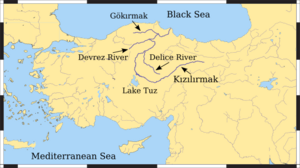
After the Roman victory at Mount Olympus, the Tectosagi under the command of their chief Komboiomaros asked to meet Vulso for a conference halfway between their camp and Ancyra. The main aim of the conference was for the Tectosagi to delay the Roman attack so that they could allow their women and children to retreat across the Halys river. Their other aim was to assassinate Vulso while he was at the conference. While they were going to the conference, the Romans saw the Galatian cavalry numbering around 1,000 soldiers charging at them. In the skirmish that followed, the Galatians overpowered Vulso's small cavalry escort due to their numbers but were driven back when the 600 strong cavalry that had been accompanying the Roman foragers arrived and forced the Galatians to retreat.
The Romans spent the next two days scouting the surrounding area and on the third day they met the Galatian army consisting of about 50,000 to >60,000 men; Grainger is sceptical of this number. The Galatian cavalry had been deployed on the flanks, but was used as infantry. The Romans started the battle by attacking again with their light infantry. The Galatians were once again attacked by long-range weapons; the Galatian center broke due to the first charge of the legions and fled to their camp. The flanks stood their grounds for longer but were eventually forced to retreat. The Romans chased them and plundered the Galatian camp as the surviving Galatians fled across the river to join the women, children and the Trocmi gathered across the Halys river. Eight thousand Galatians were killed and an unknown number were captured. The location of Mount Magaba, where this battle was fought, is thought to be Elmadağ, a hill around 10 miles (16 km) from modern day Ankara.
Aftermath
These two crushing military defeats forced the Galatians to sue for peace. This campaign greatly enriched Vulso and his legions as the Galatians had gathered great wealth through their many conquests in Asia Minor. The Galatians sent envoys to Vulso asking for peace but because winter was approaching, he had returned to Ephesus. Vulso remained in Asia Minor for another year. During that time he concluded the Treaty of Apamea with Antiochus and divided the lands of the Asia Minor coast between Pergamum and Rhodes. When the Galatian envoys came, Vulso told them that King Eumenes II of Pergamum would give them the terms of the peace when he returned from Rome. The terms given to the Galatians at Lampsacus were to cease their raids and to stay confined within their own lands, however they were not put under Roman or allied control but were left free. Envoys from cities in Asia Minor settled by Greeks came to congratulate Vulso for his victory against the Gauls.
Chiomara was the wife of Orgiagon, a Galatian chief. She was captured after the war by the Romans and dishonored by a centurion. When he returned her to the Galatians for a ransom, she signaled to one of her tribesman, who then killed the centurion.
Vulso began his return journey to Rome in 188 BC and arrived in 187 BC. He returned via Thrace, Macedonia, Thessaly and Epirus. On his return journey, he was attacked twice by Thracian thieves. The first attack was at Cypsela (now İpsala), where the middle of Vulso's column was attacked by 10,000 Thracians when the Roman vanguard had marched past the Thracian position and the rearguard had not yet come into their line of sight. The second attack by the Thracians was at Tempyra in southern Thrace, where the Trausi/Thrausi, a Thracian tribe, were the attackers. A lot of loot was stolen by the Thracians and an unknown number of Vulso's men were killed, including Quintus Minucius Thermus, a commissioner sent to advise on the Treaty of Apamea.
When he returned to Rome, he received much criticism because of his unauthorized war against the Galatians. However, he eventually overcame the opposition and was awarded a triumph by the Senate. At the triumph, a minimum of 52 Galatian chiefs were exhibited in chains. All soldiers of the army were paid 168 sestertii (equivalent to 42 denarii) each from the spoils of war, officers were paid twice as much while cavaliers were paid thrice as much. The loot Vulso brought to Rome was used by the Roman Senate to pay off the debts it had incurred during the Second Punic War. The citizens were paid through a senatus consultum, a resolution of the Roman Senate. The approximately 10,000 strong legionaries of Vulso's army were paid a second stipendium.
The loot from this campaign paraded at Vulso's triumph had 2,400 pounds (1,100 kg) of gold crowns, 220,000 pounds (100,000 kg) of silver, 2,103 pounds (954 kg) of gold, 127,000 Attic tetradrachmas, 16,320 gold philippics and 250,000 Attalid coins. The loot taken during this campaign was so large that all the Roman ships on the Anatolian coast could not carry it; Athenaeus had to provide the Pergamese fleet to carry the remainder. As a result of the campaign and its loot, Greco-Asiatic rituals and luxury began to be introduced to Rome. Livy and other ancient historians blamed these influences for the moral decline of the Roman Republic. Livy had observed the following about the triumph and its consequences:
These were the men who first brought into Rome bronze couches, expensive bedclothes, tapestries... This was when girls playing harps and lutes began to appear at dinner parties... and when a cook began to be a valued possession.
The historian Philip Kay argues that the loot brought by Manlius contributed to increased spending on infrastructure, particularly by the censors of 184, 179 and 174 BC. Some projects named by Kay are the new port and commercial infrastructure in Rome in the late 190s BC; the remodeling of the Roman sewerage system at an expenditure of 6 million denarii; construction and renovation of roads in Italy; and the building of large structures such as the Basilica Porcia, the Pons Aemilius, the Basilica Aemilia and the Macellum of 179 BC among others.


